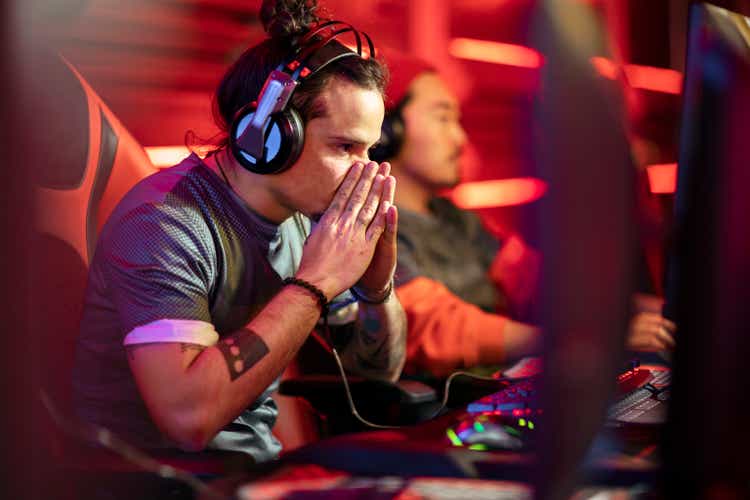Marko Geber/DigitalVision via Getty Images
Inspired Entertainment, Inc. (NASDAQ:INSE), a business-to-business gaming technology firm that supplies products and services to gaming operators around the world, has been facing some significant headwinds, and in light of rising costs outside of the control of the company, it has been performing fairly well.
There was a mixture of results from its segments, with some performing well and others, as a result of rising costs, being a drag on the performance of the company. Those costs aren’t likely to go away for the next two to three quarters, so those challenges are probably going to remain, although the company stated it believes it may be able to resolve those issues in the near term.
If it’s able to do that, INSE could surprise to the upside in the quarters ahead.
In this article we’ll look at some of the numbers from its recent earnings report, how it segments did, and what’s likely to happen over the next year or so.
Latest numbers
In the third quarter, INSE generated revenue of $74.9 million, down 3.48 percent year-over-year, but beating estimates by $2.91 million.
EPS in the reporting period was $10.2 million, or $0.35 per share, beating by $0.08.
Adjusted EBITDA in the quarter was $27.8 million, down 8 percent year-over-year.
Adjusted EBITDA margin shrunk from 39 percent last year in the same reporting period to $37 percent in the third quarter of 2022. That was attributed primarily to supply chain issues and cost inflation in its Holiday Parks business.
Another bright spot for the company is, even with the challenging economic environment it’s operating in, it continues to throw off decent cash flow, with it climbing sequentially from $31.8 million to $37.4 million in the reporting period. CapEx at the end of the reporting period was $9.3 million, bringing the total for the year to $31 million, already above the average full-year CapEx of about $30 million the company has historically spent.
Cash in the quarter dropped to $37.4 million, down $10.4 million from the $47.8 million it held at the beginning of the quarter. INSE holds $257.1 million in debt.
Performance by segment
Virtual Sports and Interactive
Its Virtual Sports segment generated record revenue of $14.6 million in the third quarter, up 39 percent year-over-year. Revenue from online Virtual Sports was up more than double what it was last year in the same reporting period.
Revenue from Interactive was $5.7 million, down 6 percent from the third quarter of 2021. Most of the revenue in that segment came from the North American market, especially in Pennsylvania where there was an increase in operators and game title launches in the quarter.
Gaming and Leisure
Revenue from Gaming was $24.1 million, a decline of 12 percent year-over-year. In the quarter the company had released only 6 games versus 22 in the first half. Now that the Christmas season is here, management stated the number of games released will increase. That should, in turn, generate more Gaming revenue in the fourth quarter.
Leisure revenue fell 9 percent to $30.5 million. Leisure is the biggest challenge for INSE because of narrowing margins associated with inflationary costs in energy and utilities. With newly signed extensions and/or contracts with Betfred, Bourne, Butlins and Marston’s, that is probably going to improve in the months ahead.
Price share movement
While INSE has been taking some good steps and positioning itself for long-term growth, it continues to struggle to break out, as it’s trading today less than it was 5 years ago, when it was trading over $13.00 per share in mid-2017 through the end of the third quarter before its share price fell off a cliff to under $5.00 per share in May of 2018.
It remained on a roller coast ride from there until the latter part of 2019, when concerns over the potential pandemic (at the time) resulted in its share price plummeting to under $2.00 per share.
After that it began a nice upward move to its 52-week high of $15.81 in February 2022, but once again came under pressure, dropping to under $8.00 per share in July of 2022, and traded in a range of a little under $9.00 per share to about $10.50 per share before it broke out on November 8, 2022, in response to its earnings report, presumably in response to its improvement in its earnings per share.
Looking at that move of approximately $1.00 per share, I’m not convinced the company has the catalysts in place to drive its share price higher.
Conclusion
Taking the numbers and performance of the company into account, along with its long-term debt, cash on hand and cash flow, I see them being somewhat of a counterbalance to one another, and for that reason think the company is going to trade level in 2023, and possibly on an incremental upward trajectory if some of its recent deals generate some good results.
My thesis is INSE needs to be more aggressive in pursuing the North American market if it wants to break out of its 5-year trading ceiling in the mid-$14s.
Even if it takes some time to do so, it could be a decent long-term play in the sector it competes in if it gains market share in the North American market.
Outside of that, I’m not seeing as many growth opportunities that will have a significant impact on the performance of the company, other than at an incremental basis.
As for the fourth quarter of 2022 and 2023, the company will continue to face inflationary pressures, and with modest catalysts in its pipeline, I think it will probably trade in a consolidated fashion until some of the costs are mitigated and more growth drivers are added to the company’s product and services offerings, which will help it gain some momentum.


Be the first to comment